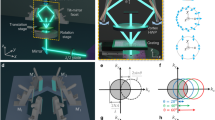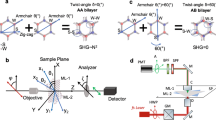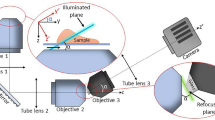Abstract
IT has already been pointed out1 that the Smith type of interference microscope, using a Wollaston prism in the rear focal plane of the objective, is a suitable instrument for measuring thin films. The film is deposited, with a reasonably sharp edge, on a flat surface and covered with a reflecting metallic film, using, for example, silver or aluminium. The image of an illuminated slit, doubled by the Wollaston prism, is projected by the objective, via a prism type of vertical illuminator, normally on to the specimen. The reflected beams are polarized mutually at right angles and the path-difference between them is zero if both slit images fall either on to the substrate only or on to the film only. If one image falls on to the film and the other on to the substrate the path-difference is equal to twice the film thickness, and the problem becomes the polarimetric one of measuring this path-difference.
This is a preview of subscription content, access via your institution
Access options
Subscribe to this journal
Receive 51 print issues and online access
$199.00 per year
only $3.90 per issue
Buy this article
- Purchase on SpringerLink
- Instant access to full article PDF
Prices may be subject to local taxes which are calculated during checkout
Similar content being viewed by others
References
Dyson, J., Physica, 24, 532 (1958).
Billings, B. H., J. Opt. Soc. Amer., 39, 797 (1949). Takasaki, Hiroshi, ibid., 51, 462, 463, 1146 (1961).
Author information
Authors and Affiliations
Rights and permissions
About this article
Cite this article
DYSON, J. Very Precise Thickness Measurement of Thin Films. Nature 197, 1193 (1963). https://doi.org/10.1038/1971193a0
Issue date:
DOI: https://doi.org/10.1038/1971193a0



